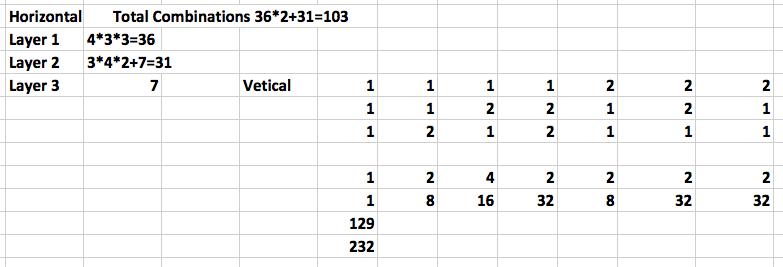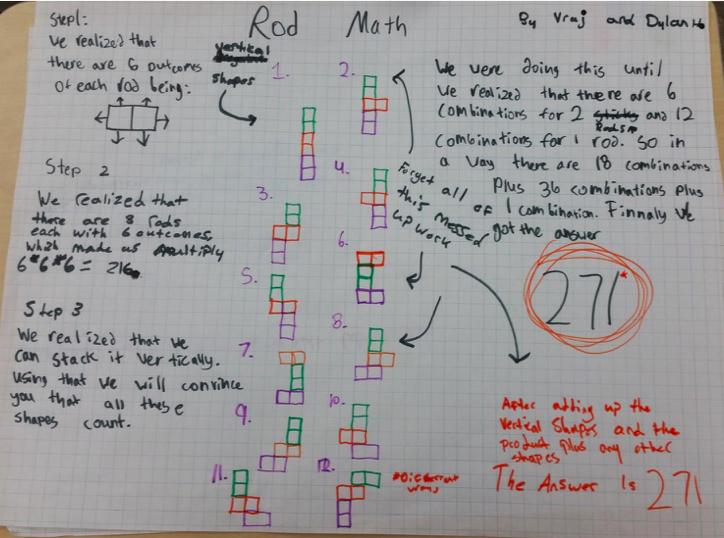Building with rods
In how many ways can you stack these rods, following the rules?
Problem
We have three rods that are each 2 units long.
The different colours are used to make the diagrams clearer and they always remain in the same place i.e the blue as the bottom layer, the green as the top layer and the red as the middle layer.
The challenge is to find how many different ways you can stack these rods.
The rule is that one or both of the small cubes must sit squarely on top of other small cubes.
It does not matter if they are likely to topple over.
Both these two arrangements fit the rule.

However, these two arrangements below do not fit the rule as the rods have to be lined up squarely and each little cube must sit on top of one other cube and not overlap two cubes.

How can you convince someone that you have found all the possibilities?
Student Solutions
We had a number of really good solutions sent in from Caledon East Public School in Canada. Different answers have been obtained because of deciding what is and is not allowed.
First of all Edwin's:
The blue brick has 2 possible positions: Flat and upright. For flat, there are 9 possibilities for the red brick. For upright, there are 5 possibilities for the red brick.
The red brick stands upright in this 3 times (twice on the flat blue and once on the upright). When the red brick stands upright, there are 5 possibilities for the green brick. When the red brick is flat (and there are 11 possible positions for the red brick when it is flat), there are 9 possibilities for the green brick.
How I could convince someone that I had found all the possibilities:
I could convince someone that I had found all the possible ways to stack these blocks either by explaining my equation or by getting out some blocks to show them that I am correct.
Edwin has been creative in thinking of the vertical arrangements.
Then Guangyan wrote:
I think the answer is infinity. If my theory is true, that a shape's orientation is a different shape because that if you mark each corner, it would be different. So the bottom cubes could be put virtually anywhere, and that is why I think the answer is infinity.
Another creative thought from Guangyan that shapes can be put in an infinite number of different places.
Adrian sent in a part of a spreadsheet:
My answer is 232 and my work is messy so you may not be able to understand my work. This area in the Excel Sheet is my work for this question:

Opkar and Navin wrote that they found 125 combinations using a formula after drawing a few
combinations to see the pattern.
Dylan sent in his work:
This is our solution. Our final finished answer is 271, we came up with this solution by trying to find formulas and adding any other types of combinations that were not in our formula. We apologize for any mistakes and messy work/typos.

I've included this work because it shows a good start but there is a little more to do.
Waliyya wrote:
I think the answer is 162 because I know that the bottom rod has 2 possibilities, vertical and horizontal and the two rods on top had 9 possibilities (Horizontal, vertical, hanging out, forward, backward, and all of those except for horizontal on the other side) which is why I did 2 x 9 x 9 which was 162.
Finally Nikhitha also went for 162:
I believe the answer to this problem is 162. I believe this because the rod on the bottom has two positions which are vertical and horizontal and the middle and top rod have nine movements each so the calculation I did was 9 x 9 x 2 which gave me my answer 162.
Waliyya and Nikhitha worked with their own criteria about what was possible and therefore they came to make the total number 192.
Oskar and Brandan from Stanley Park Junior School, Carshalton sent in this:
There are 49 possible combinations of cuboids, because there are 7 possible ways of stacking 1 cuboid aloft another. Because of this there are 7 possibilities for red and blue and for each of these cases there are 7 more possibilities of combinations so there are 7 x 7 or 49 total sculptures.
Thank you Oskar and Brandan for your work - you stuck to horizontal arrangements and got therefore 49 as the answer.
Thank you everyone. If you are looking at this as a new activity you may find different answers according to the 'rules' you agree on.
Teachers' Resources
Why do this problem?
Possible approach
Key questions
Can you describe the ways that you arrived at these shape arrangements?
How did you construct these on the computer?
Possible extension
Possible support
Teacher Support
This task was created to help in the pursuance of curiosity within the Mathematics lessons.
Help may be found in the realm of curiosity in watching parts of these excellent videos.
Firstly "The Rise & Fall of Curiosity", particularly the extract [23.50 - 37.15] on "adult encouragement answering and teacher behaviour."
Secondly, "The Hungry Mind: The Origins of Curiosity", particularly the extract [8.22 - 12.29] on "Children asking questions"
First can also be found at - https://www.youtube.com/watch?v=X-0NOrIU67w
Second can also be found at https://www.youtube.com/watch?v=Wh4WAdw-oq8
